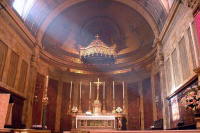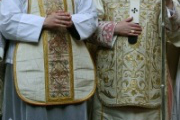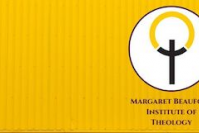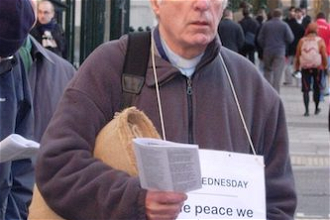Text: homily at Birmingham Oratory Mass for transfer of remains of Cardinal Newman
Fr Paul Chavasse, Provost of the Birmingham Oratory and Postulator for the Cause for the Beatification and Canonisation of the Venerable John Henry Cardinal Newman.
We have come to the Oratory in such large numbers this morning and many more are joining us around the world as this Mass is being broadcast live to take part in what is admittedly a rather unusual event. In the so familiar context of the Mass we are doing something which is profoundly unfamiliar, even, some would say, odd. The earthly remains of a man who died in 1890 are with us yet this is not a funeral, it is not even remotely a sad event. We are here to transfer these sparse remains and to place them, with great love and reverence in a new home, where, if it pleases Almighty God, they will become in the not too distant future the focal point for the shrine of a new saint.
By and large, when we die, we would quite rightly expect to remain in the spot where we had been lain to rest, or where perhaps our ashes had been scattered. That is the common thing, indeed the proper thing, to do. It is the last word said about us and over us as our funeral ends. Yet sometimes it transpires that the last word has not been said. In the Church of Christ there has been since the earliest days the desire to have the protection of the Saints and this expresses itself in the seeking for the assurance given by their abiding physical presence. The believer feels that there is a virtue and an influence still left even in the mortal remains of such holy men and women. So their bodies are not left in the peace the world generally understands, but they are accorded a place and an honour which reflects what the Church thinks about them. They are to be a daily influence in our lives and their relics enable us to be mindful of them, to be in touch with them, always.
The recognition by the Church of this deeply Christian and human need led of course in the passage of time to the creation of some wonderful and most beautiful shrines in this part of the world we can think of St Chad at Lichfield, or Ss Oswald and Wulstan at Worcester; we can think of St Thomas at Canterbury and further afield in Europe St James at Compostella or St Stanislaus in Cracow. This desire, this custom, has not diminished down the centuries: new ones can be found like Blessed Pope John XXIII in Rome or Blessed Mother Teresa in Calcutta: modern saints in modern shrines.
So what we do today is of a piece with all of this it is one of the ancient traditions of our Church being enacted as we watch and pray.
Some of you may be thinking that the man we honour today Cardinal John Henry Newman is not yet a saint, nor even yet a Blessed, as indeed that is the case. Is therefore what we are doing premature or presumptuous? I would answer: No. Even though today we cannot pay the honour to these remains which we hope to be able to do some months in the future you will notice for example the colour of the candles yet without presuming on the judgement of the Church, we still know through our Catholic instincts that what we can do honours not only a fellow Christian, but a great and holy man, whom many see as a special friend and intercessor with God, as well as one who is an inspiration to so many people in their own pilgrimage of faith, their own journey from "shadows and images into the truth." It is truly right and fitting that we honour that.
So, a great and holy man is honoured today. We keep this Sunday as the Feast of All Saints and in doing so we honour all the holy men and women of every age and place now with God in Heaven. This celebration therefore teaches us, if it teaches us anything, that holiness is what we are all called to show forth. It is not the preserve of the few, not even the vocation of the many; it is the call given to us all without exception. The Gospel we have just heard tells us of the Beatitudes it lists for us the graces and virtues, the attributes and behaviour we must manifest if we are to be recognisably on the way to being holy. Hearing the Beatitudes on this feast should make us reflect as to whether this is a description of my life today. Is it a more accurate picture of me today than it was this day last year? Do I at least recognise in it a list of the things I struggle to be, want to be, with Christ as my guide and with His grace transforming me? If we take our Christian vocation seriously, if we truly want to become what Christ calls us to be, then the Beatitudes must forever remain the foundation charter for our lives. We should not say: "This could be me" but "This will be me", even if not completely here on earth, then at least after Purgatory has done its job and I am with God in heaven.
We do know of course that even here on earth there are those who show forth the life of the Beatitudes to a high degree. Cardinal Newman himself wrote of them as the ones who "have set up a standard before us of truth, of magnanimity, of holiness, of love". They are "raised up to be monuments and lessons, they remind us of God, they introduce us into the unseen world, they teach us what Christ loves....". In 1991 the late Pope John Paul II recognised that this was true of John Henry Newman himself, and, in declaring the Cardinal "Venerable" - that is "able to be venerated" - he was saying that this great Englishman had indeed lived the Beatitudes, the virtues of the Christian life to an heroic degree. Not to perfection, of course not, but to a degree quite out of the ordinary that is what a hero is and that his example is worthy of being imitated by us. "A Saint in the making" who already calls others to aspire to a similar state of life.
Some may say that this role of Cardinal Newman rests on all his life's work: his writings, his sermons, the encouragement and advice he gave to others in his letters, his tireless work for educating the laity, his service of the poor here in Birmingham the list goes on and all of it is true. We don't need physical remains in order to be inspired by a man like that. And yet: despite it all the human heart still longs for the visible, for that special tangible reminder of the one who has touched and shaped our lives for the better, whether it is Cardinal Newman or someone else whom we love or hold in veneration how we will treasure that particular photograph, that special letter, and, yes, that lock of hair.
But that said, it is as well that the Church's process does not depend on the presence of the physical remains of those she advances as her canonised saints. Those of us who were present at Rednal just a month ago, when the Cardinal's grave was opened, will never forget the range of emotions through which we passed: Bewilderment that the "shallow grave" reported in 1890, should now be eight feet deep; frustration that foot after foot of earth revealed precisely nothing; worry that perhaps after all and incredibly we might be in the wrong spot; shock at what little was eventually found, and then at the end and most strangely, a sense of the rightness of what had transpired, a feeling of peace, peace of mind that after all Cardinal Newman's fondest wishes had actually been fulfilled. That experience shows too that even after 118 years since he died Cardinal Newman still wanted to teach us a lesson. What is it?
It is surely the lesson the month of November speaks to us about: it is the lesson that our common end, be we who we may, is death and decay and the dissolution of all things. The month begins with All Saints and All Souls: we will all be swept up into that great mass of all the faithful departed, and we hope to become, sooner or later, one with the saints of God. But November ends with the Feast of Christ the King to remind us who it is we must love and serve, to remind us whose is the Kingdom to which we truly belong, to remind us whose gentle and all persuasive rule calls us from the transitoriness of this life to the glory of the life of the Resurrection. That path to the Kingdom is not always easy: as Cardinal Newman himself wrote: "All God's providences, all God's dealings with us, all his judgments, mercies, warnings, deliverances, tend to peace and repose as their ultimate issue ... after our souls' anxious travail; after the birth of the spirit; after trial and temptation; after sorrow and pain; after daily dyings to the world; after daily risings unto holiness; at length comes that 'rest which remaineth unto the people of God'. After the fever; after weariness and sicknesses; fightings and despondings, languor and fretfulness; struggling and failing, struggling and succeeding; after all the changes and chances of this troubled unhealthy state, at length comes death, at length the white throne of God, at length the Beatific Vision."
The lesson we must learn is that, as the Cardinal also said: "He knows what He is about", and that life's trials and difficulties, its joys and its beauty all have the object of shaping us to be friends with God, to be at one with Our Lord: this is the aim and purpose of life. That is what John Henry Newman put into practice his whole life-long; it is what he taught others to do, it is what he is calling us to do today.
Cardinal Newman has left us but few earthly remains as focal points for our devotion, as if, and quite explicitly, to point us to that higher goal as a son of St Philip should to lead us away from himself and, as he put it in his hymn to St Philip, "towards the bright palace where our God is present throned in high heaven." That is what we would want for us as for himself, and the poignancy of his all but empty grave speaks loudly of it.
Today's ceremony marks an important moment in the history of the Cause for the Cardinal's Beatification. That event lies in the future. As most of you know, we still await the completion of the final stages of the process in Rome. As much as we would like it to be otherwise, these cannot be hurried and the due process takes its time. We are often asked and many times this week alone when will it be? All I can say is, and it is only a guess, that if the remaining stages are successfully and smoothly passed, we may have the joy of a beatification ceremony round about this time next year. So we must pray, and pray hard, for that to happen the great desire of so many people. During the Vigil of Reception for these remains, a book was placed in the Cloisters where pilgrims, visitors, could write their requests and prayers having read some of them I know how deeply moving these are. What a depth of trust they reveal in the intercessory power of our Cardinal! What faith in him as their friend with God! No shadow of a doubt there that a Saint is waiting to be so proclaimed!
So, let us therefore honour the memory of this great and good and holy man, and do it with rejoicing as Catholics should; let us treasure and revere these locks of hair, the shattered bits of his coffin, the Cross of Christ he proudly wore, as the signs they are of the life he spent on earth in love of Christ, and of that body of his that was spent in his service of Christ's people. His continued existence beyond that empty grave is a fact as certain as your existence or mine; he most surely has not forgotten us; he most surely remembers us, and in remembering, cares for us and will do his best for us, as all the saints should. But in what remains, in its very frailty and decay, let us also see what he would want us to see: a pledge of that day when all that has been lost and dissolved in the earth will rise again in the glory of the Resurrection and the life of the world to come. Amen.





















